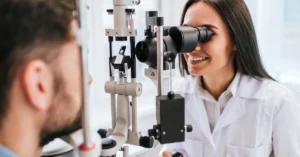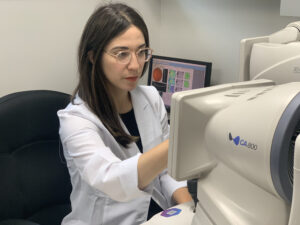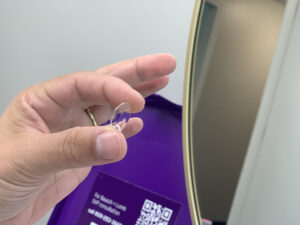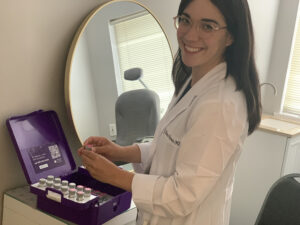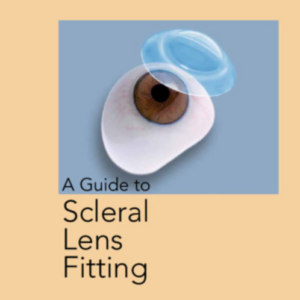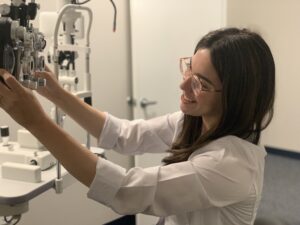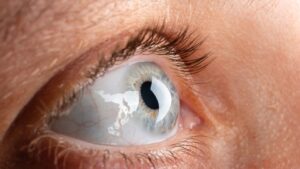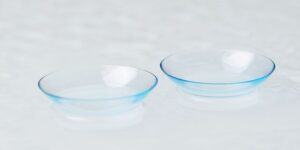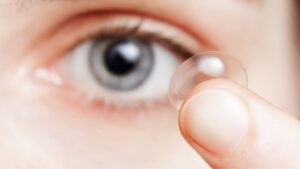What Are Scleral Contact Lenses?
Scleral lenses are specialised contact lenses that are used to treat a variety of severe eye conditions. They are larger in diameter than traditional contact lenses and have a unique shape that allows them to vault over the entire cornea and rest on the sclera (white part of the eye). This design provides several benefits for people with certain eye conditions. Here are 5 severe eye conditions that can be treated with scleral lenses:
1. Keratoconus
Keratoconus is a progressive eye condition in which the normally round cornea (the clear front part of the eye) becomes thin and cone-shaped. This irregular shape can cause vision distortion and blurriness. Keratoconus can occur in one or both eyes and typically develops in people in their teenage years or early 20s. It is thought to be caused by a combination of genetic and environmental factors.
Scleral lenses are an effective treatment option for people with keratoconus. Unlike traditional contact lenses, which rest on the cornea, scleral lenses are larger in diameter and rest on the white part of the eye (the sclera). They are custom-made to fit the unique shape of each individual’s eye and provide a smooth, uniform surface for light to pass through, resulting in clearer vision.
Scleral lenses are also beneficial for people with keratoconus because they provide a protective barrier for the cornea, which can help prevent further damage to the eye. They can also help reduce the discomfort and irritation that often occurs with traditional contact lenses in people with keratoconus.
2. Dry Eye Syndrome
Dry eye syndrome is a common eye condition that occurs when the eye does not produce enough tears or the tears evaporate too quickly. This can cause symptoms such as dryness, burning, itching, and redness of the eyes. Dry eye syndrome can be caused by a variety of factors, including age, certain medications, and certain medical conditions.
Scleral lenses can be an effective treatment option for people with dry eye syndrome. The lenses create a moisture chamber over the eye, which helps to keep the eye hydrated and comfortable. They also help to reduce tear evaporation, which can further improve symptoms of dry eye syndrome.

3. Corneal Scarring
Corneal scarring occurs when the cornea becomes damaged, usually due to injury or infection. Scarring on the cornea can cause vision distortion and blurriness, as well as discomfort and sensitivity to light.
Scleral lenses can be an effective treatment option for people with corneal scarring because they provide a smooth, uniform surface for light to pass through, resulting in clearer vision. They also provide a protective barrier for the cornea, which can help to reduce discomfort and sensitivity to light.
4. Corneal Ectasia
Corneal ectasia is a rare condition in which the cornea becomes thin and bulges outward, resulting in vision distortion and blurriness. It can occur after certain eye surgeries, such as LASIK, or it can be a complication of keratoconus.
Scleral lenses can be an effective treatment option for people with corneal ectasia because they provide a smooth, uniform surface for light to pass through, resulting in clearer vision. They also provide a protective barrier for the cornea, which can help to prevent further damage to the eye.
5. Irregular Corneal Shapes
Irregular corneal shapes can occur for a variety of reasons, such as corneal scarring, corneal ectasia, or keratoconus. These irregular shapes can cause vision distortion and blurriness.
Scleral lenses are an effective treatment option for people with irregular corneal shapes because they provide a smooth, uniform surface for light to pass through, resulting in clearer vision. They are also custom-made to fit the unique shape of each individual’s eye.
6. Post-LASIK ectasia
LASIK is a surgical procedure that is used to correct vision. However, in some cases, the cornea may become thin and weakened after the procedure, leading to a condition called post-LASIK ectasia. Scleral lenses can help to correct vision in people with post-LASIK ectasia by providing a smooth, even surface for light to pass through and improving the overall shape of the cornea.
6. Post-RK Surgery
Radial Keratotomy is another surgical procedure used to correct nearsightedness by making radial incisions in the cornea to flatten its shape and reduce its refractive power. However, this procedure can often cause irregular astigmatism, which leads to distorted and blurry vision.
Here are some specific ways in which scleral lenses help with post-RK surgery:
1. Correcting irregular astigmatism: Scleral lenses can neutralize the irregular corneal shape caused by RK surgery. By vaulting over the cornea and providing a smooth, evenly refracting surface, they can improve vision by minimizing or eliminating the distortions caused by astigmatism.
2. Improving visual acuity: Scleral lenses can significantly improve visual acuity by providing a custom-fit lens that corrects the specific refractive errors of the individual’s eyes. The precise design of scleral lenses can correct both nearsightedness and farsightedness, helping patients achieve better visual clarity.
3. Enhancing comfort and reducing dryness: After RK surgery, the cornea can become dry and more sensitive due to reduced tear production. Scleral lenses, with their large size and tear reservoir, act as a protective barrier that helps retain moisture and reduce dryness. This can greatly increase comfort for post RK patients who may experience dry eye symptoms.
4. Shielding the cornea: The larger size of scleral lenses can provide physical protection to the cornea, especially in cases where the cornea is thin or weakened due to RK surgery. This protection helps prevent further damage to the cornea and allows it to heal properly.
It is important to note that every individual’s vision needs are unique, and the success of scleral lenses in post-RK surgery cases may vary. Consulting an eye care professional experienced in fitting scleral lenses is crucial to determine if they are the right solution for a specific patient.

